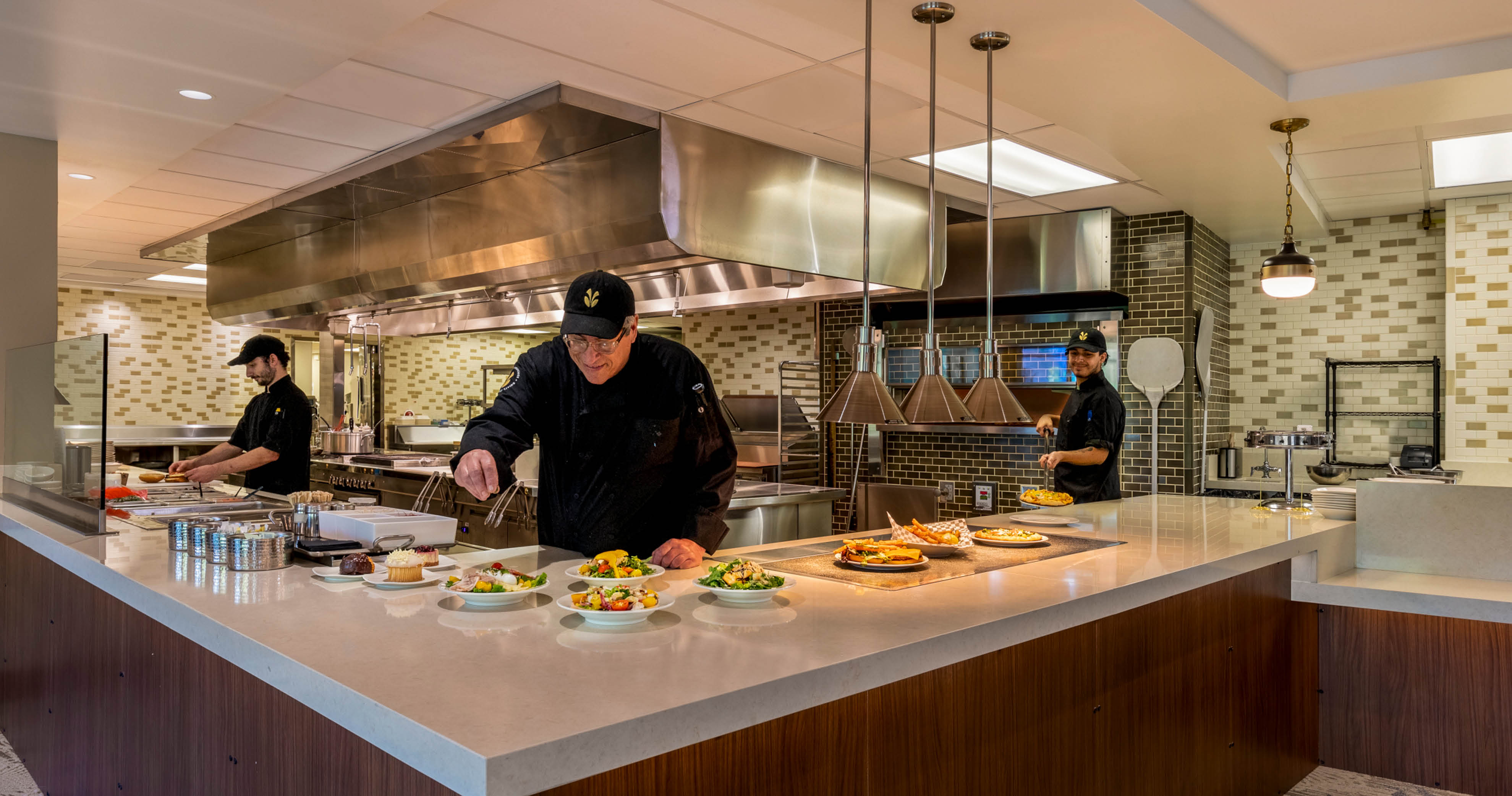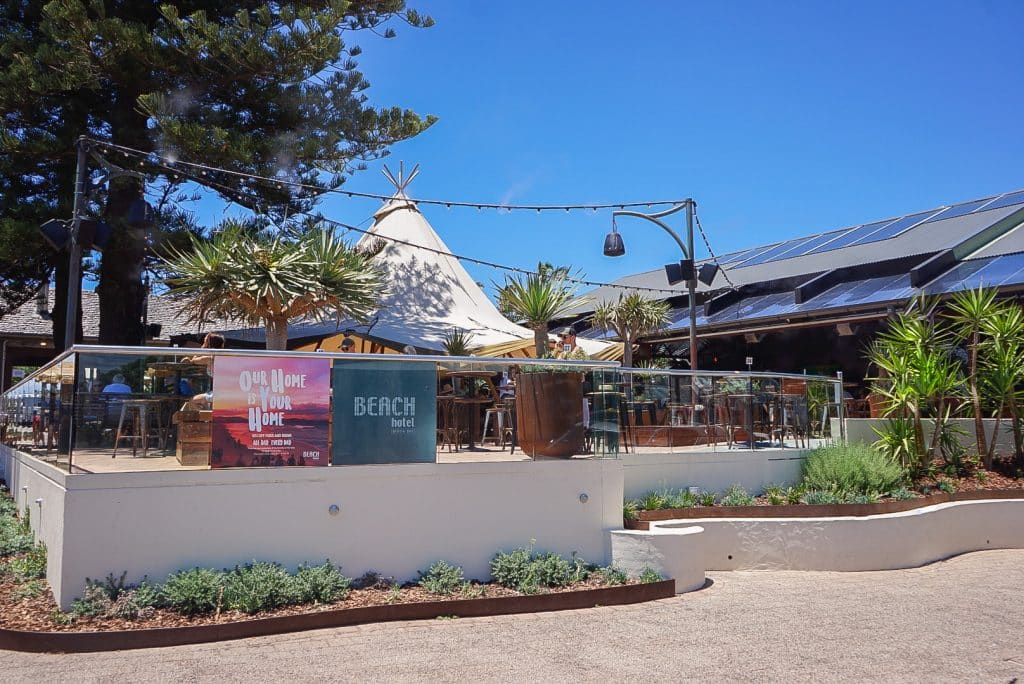
The Springs at Lake Oswego, a senior living community in Oregon, is not just a wonderful place to live but also, according to Ray Soucie FCSI, LEED AP, senior project manager for Webb Foodservice Design in Portland, Oregon, a window into what is possible in this increasingly important institutional segment.
Located on 4.5 acres, the community consists of 216 units with residences ranging from independent living to assisted living and memory care. It features dining and social amenities including a pub, private dining room, wine tasting room, indoor pool, fitness center, cinema, rooftop patios, putting green and bocce court.
Its main floor features multiple ADA-accessible foodservice venues including an intimate lounge called Fancho’s offering a full-service bar and seating for 42. The main dining room seats 142 and includes a full display kitchen offering views of the center island chef’s cooking suite and a private chef’s table room with a full wall dedicated as a wine vault.
The budget for the community’s construction was approximately $65m. The project started in March 2016, and residents began moving in during January 2020. It was back in March 2016, right at the start, that executives from The Springs Living contacted Ray Yancey of MGA architectural about the project, recalls communications director Tracy Darchini, “after having had a successful experience working together on one of the company’s other senior living communities.”
According to culinary director Sam Currie, The Springs Living has had a long-term relationship with Soucie (who is featured in FCSI’s Future-tech roundtable on innovation in healthcare foodservice, here).“He was the foodservice consultant retained to design The Springs at Greer Gardens community in Eugene, Oregon. Our director of design, Chris Shelby, appreciated Ray’s experience and insight.”
This is the largest of the company’s communities to date, says Currie, “and Chris wanted to work with the same team who successfully collaborated on Greer Gardens. He trusted Ray’s insight and wanted to deliver a successful sustainable building for the community.”
Design challenges
Management wanted to offer a unique choice for senior living with the quality amenities and services commensurate with the lifestyle of the greater community. Locating the property in the heart of the town also enables family members to easily spend time with their loved ones.
Soucie identified several primary challenges for foodservice design. First the space is a multi-story building with a unique shape. There are two kitchens: the main on the ground floor and an assisted living kitchen on the second floor. While each operates independently, the assisted living kitchen relies on the main one for food storage and banquet catering support. When required, batch cooking is done in the main kitchen and transported via staff elevator to the assisted living kitchen.
Locating a display kitchen at the end of a long rectangular dining room was also a challenge. The dining room’s shape changed angles at the end. As Soucie recalls: “Instead of fighting the architecture of the building we accentuated it and used the end of the dining room as a way to lure residents in. That is where we located the display cooking island and welcomed residents to view it by providing a grand open counter.”
A positive collaborative effort
Early interaction between the operator and the consultant should always include both a representative of the architectural team and the owner, Soucie reflects, adding: “Making sure everyone on the design team understands the goals and limitations is key to a successful outcome.”
Clearly writing out guiding principles and cross-checking to see that the design team adheres to them throughout the process contributes to a positive collaborative effort. If changes are made without cross-checking with the other design disciplines, expensive last-minute construction change orders can cripple the budget. “We want to avoid putting the owner in a position of having to choose between their vision and the realities of construction costs,” Soucie explains.
The Springs Living wanted to ensure that the dining experience was both entertaining and interactive. Opening it up not only enables interaction between the staff and residents, but offers the opportunity for cooking classes, chef demonstrations and display cooking. Another key interactive component was the location of the chef table room. A glass wall is all that separates the dining table from food preparation. The opposite wall features a glass wine vault for residents, creating a striking visual.
A second design element used to draw people in is a custom-built all-glass display refrigerator. “We located it at the end of a long hallway that residents would walk down before turning towards the dining room entrance,” says Soucie. The refrigerator was inserted into an arch cut out into the wall between the hallway and kitchen. This ensured residents would see seasonal produce and artisanal products through the back of the refrigerator as they approached the dining room.
Innovation enhances design
Other innovative features include:
- Combining multiple exhaust systems through the five-story building without impacting residence living space. As Soucie recalls, “We specified a Gaylord Demand control system, which enabled us to combine duct shafts and reduce both air volume and the number of exhaust fans on the roof.” This reduced noise impact on the residence and contributed to sustainable savings overall.
- Sustainable combined remote refrigeration was also implemented where applicable. One refrigeration rack was specified to handle both the larger walk-in coolers in the back of the house and the refrigerated drawers underneath the cooking island. This removed heat and noise from the display kitchen while providing much-needed refrigeration space directly under the cook tops.
- An espresso and hot tea café features locally roasted, sustainable coffee and world-class tea offerings combined with walk-up quick-service bakery and food options. Soucie and his colleagues also eliminated waste disposers using a Salvajor waste collector and specified a Hobart heat-recovery dish machine. This drastically reduced water consumption and electrical draw by eliminating a water heater.
Fancho’s, centrally located near the main entrance, is intended to enhance community interaction and serve as the residents’ den. Portland Trail Blazers basketball fans can congregate to cheer their team while maintaining a family atmosphere for a quick snack or light meal. During the day the island bar features a coffee and breakfast stop or a quick take-out for those visiting.
The display kitchen offers multiple focal points of interest. There is an open-flame pizza oven that can be seen from the dining room; a counter-top walk-up area that invites residents to interact with the chefs; a European-style chef’s cooking suite; a small bakery in the background; and a view to the private chef’s table room.
When designing complicated, yet sustainable, mechanical design systems, Soucie says: “Work closely with the MEP engineering team early on. Make sure coordination of building systems is thought out in advance. Focus on mechanical maintenance shutdown options that may affect operating procedures. This is not only a foodservice facility but also a residence. Family dynamics can be affected by design choices made.”
Howard Riell




